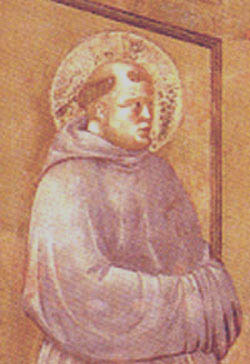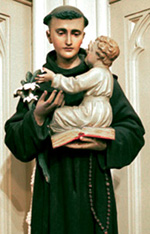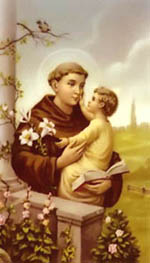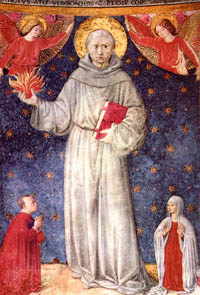From breviary.net, here are Lessons iv. v. and vi. from the Divine Office readings for the Feast of St Anthony of Padua, first a member of the Canons Regular of St Augustine, then a Franciscan (no link, only the Almighty knows how many Franciscan web sites there are), confessor and doctor of the Church, and some information about this Saint, whose cult has survived for over seven hundred years.

St Anthony of Padua with the infant Jesus, from the Basilica of St Anthony.
|
Antonius, Ulyssipone in Lusitánia honestis ortus paréntibus, et ab iis pie educatus, adoléscens, institutum canonicórum regulárium suscépit. Sed, cum córpora beatórum quinque Mártyrum fratrum Minórum Conímbriam transferéntur, qui paulo ante apud Marrochium pro Christi fide passi erant, martyrii desidério incénsus ad Franciscanum ordinam transívit. Mox eodem ardore impulsus, ad Saracenos ire perréxit ; sed, adversa valetúdine afflíctus et redire coactus, cum navi ad Hispaniæ littora ténderet, ventórum vi in Siciliam delátus est. |
Anthony was born of decent parents at Lisbon in Portugal. They gave him a godly training, and while he was still a young man, he joined an Institute of Canons Regular. However, when the bodies of the five holy martyred Friars Minor, who had just suffered in Morocco for Christ's sake, were brought to Coïmbra, the desire to be himself a martyr took a strong hold upon him, and he left the Canons Regular and became a Franciscan. The same yearning led him to attempt to go among the Saracens, but he fell sick on the way, and being obliged to turn back, the ship in which he had embarked for Spain was driven by stress of weather to Sicily. |
|
Assisium e Sicília ad capitulum generale venit : inde in eremum montis Pauli in Æmília secessit, ubi divinis contemplatiónibus, jejuniis et vigiliis diu vacávit. Postea, sacris ordínibus initiátus et ad prædicándum Evangelium missus, dicendi sapiéntia et copia tantum profecit, tantamque sui admiratiónem commovit, ut eum summus Pontifex aliquando concionántem áudiens, arcam Testaménti appellarit. In primis vero hæreses summa vi profligávit, ideoque perpetuus hæreticórum malleus est vocatus. |
From Sicily he came to Assisi to attend the General Chapter of his Order, and thence withdrew himself to the Hermitage of Monte Paolo near Bologna, where he gave himself up for a long while to consideration of the things of God, to fastings, and to watchings. Being afterward ordained Priest, and sent to preach the Gospel, his wisdom and fluency were very marked, and drew on him such admiration of men, that the Pope, once hearing him preach, called him The Ark of the Covenant. One of his chief points was to expend all his strength in attacking heresies, whence he gained the name of the Heretics' everlasting Hammer. |
|
Primus ex suo ordine, ob doctrinæ præstantiam, Bononiæ et álibi sacras litteras est interpretatus, fratrumque suórum stúdiis præfuit. Multis vero peragrátis provinciis, anno ante obitum Patavium venit, ubi illustria sanctitátis suæ monuménta relíquit. Denique magnis laboribus pro glória Dei perfunctus, meritis et miraculis clarus obdormívit in Dómino Idibus Junii, anno salútis millesimo ducentésimo trigesimo primo. Quem Gregórius nonus, Pontifex maximus, sanctórum Confessórum numero adscripsit, et Pius duodecimus, ex Sacrórum Rituum Congregatiónis consulto, universalis Ecclésiæ Doctórem declarávit. |
He was the first of his Order who, on account of his excellent gift of teaching, publicly lectured at Bologna on the interpretation of Holy Scripture, and directed the studies of his brethren. He travelled through many provinces. The year before his death he came to Padua, where he left some remarkable records of his holy life. After having undergone much toil for the glory of God, full of good works and miracles, he fell asleep in the Lord upon the 13th day of June, in the year of salvation 1231. Pope Gregory IX enrolled his name among those of the Holy Confessors, and Pius XII, having consulted the Congregation of Sacred Rites, declared him a Doctor of the universal Church. |
One week ago, on June 6, the Church marked the feast of St Norbert, who lived at the same time as St Anthony of Padu, and shortly after Pope Gregory VII (Hildebrand). St Francis of Assisi was, of course, still alive. The Catholic Encyclopedia relates Anthony's first public preaching:
While Anthony lived retired at Montepaolo it happened, one day, that a number of Franciscan and Dominican friars were sent together to Forli for ordination. Anthony was also present, but simply as companion of the Provincial. When the time for ordination had arrived, it was found that no one had been appointed to preach. The superior turned first to the Dominicans, and asked that one of their number should address a few words to the assembled brethren; but everyone declined, saying he was not prepared. In their emergency they then chose Anthony, whom they thought only able to read the Missal and Breviary, and commanded him to speak whatever the spirit of God might put into his mouth. Anthony, compelled by obedience, spoke at first slowly and timidly, but soon enkindled with fervour, he began to explain the most hidden sense of Holy Scripture with such profound erudition and sublime doctrine that all were struck with astonishment. With that moment began Anthony's public career.Source: St. Anthony of Padua.
Fr Paul Spilsbury, O.F.M., translated all of St Anthony's extant sermons from the Critical Latin Edition of the Centro Studi Antoniani in Padua.

St Anthony Church, Jersey City, New Jersey, U.S.A., as it appears today.
One time when I visited St Anthony's in Jersey City (it is literally around the corner from Holy Rosary, the site of the Latin Mass indult in the Archdiocese of Newark), Fr Urban explained that although St Anthony's is the Mother Church of Polonia in New Jersey, St Anthony himself is beloved by Catholics all over the world. This church is one threatened with closing under Abp John Myers.




